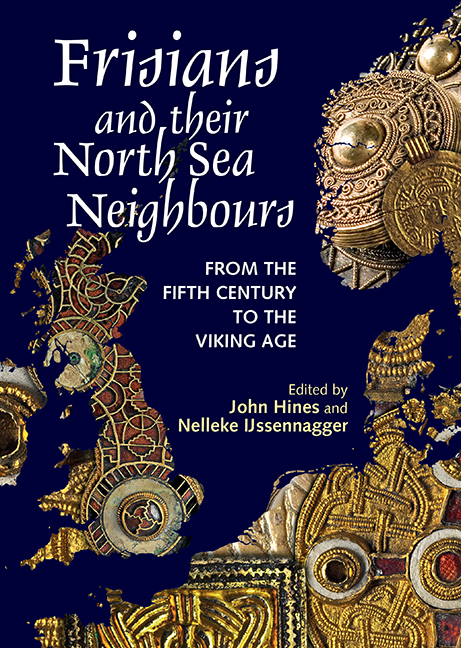Book contents
- Frontmatter
- Contents
- List of Figures
- List of Tables
- Preface
- Acknowledgements
- Linguistic Conventions and Abbreviations
- Abstracts
- Introduction: Frisians – Who, When, Where, Why?
- 1 Palaeogeography and People: Historical Frisians in an archaeological light
- 2 The Anglo-Frisian Question
- 3 Frisian between the Roman and the Early Medieval Periods: Language contact, Celts and Romans
- 4 ‘All quiet on the Western Front?’ The Western Netherlands and the ‘North Sea Culture’ in the Migration Period
- 5 Power and Identity in the Southern North Sea Area: The Migration and Merovingian Periods
- 6 How ‘English’ is the Early Frisian Runic Corpus? The evidence of sounds and forms
- 7 The Geography and Dialects of Old Saxon: River-basin communication networks and the distributional patterns of North Sea Germanic features in Old Saxon
- 8 Between Sievern and Gudendorf: Enclosed sites in the north-western Elbe–Weser triangle and their significance in respect of society, communication and migration during the Roman Iron Age and Migration Period
- 9 Cultural Convergence in a Maritime Context: Language and material culture as parallel phenomena in the early-medieval southern North Sea region
- 10 The Kingdom of East Anglia, Frisia and Continental Connections, c. ad 600–900
- 11 A Comparison of the Injury Tariffs in the Early Kentish and the Frisian Law Codes
- 12 Cultural Contacts between the Western Baltic, the North Sea Region and Scandinavia: Attributing runic finds to runic traditions and corpora of the Early Viking Age
- Index
Introduction: Frisians – Who, When, Where, Why?
Published online by Cambridge University Press: 25 August 2018
- Frontmatter
- Contents
- List of Figures
- List of Tables
- Preface
- Acknowledgements
- Linguistic Conventions and Abbreviations
- Abstracts
- Introduction: Frisians – Who, When, Where, Why?
- 1 Palaeogeography and People: Historical Frisians in an archaeological light
- 2 The Anglo-Frisian Question
- 3 Frisian between the Roman and the Early Medieval Periods: Language contact, Celts and Romans
- 4 ‘All quiet on the Western Front?’ The Western Netherlands and the ‘North Sea Culture’ in the Migration Period
- 5 Power and Identity in the Southern North Sea Area: The Migration and Merovingian Periods
- 6 How ‘English’ is the Early Frisian Runic Corpus? The evidence of sounds and forms
- 7 The Geography and Dialects of Old Saxon: River-basin communication networks and the distributional patterns of North Sea Germanic features in Old Saxon
- 8 Between Sievern and Gudendorf: Enclosed sites in the north-western Elbe–Weser triangle and their significance in respect of society, communication and migration during the Roman Iron Age and Migration Period
- 9 Cultural Convergence in a Maritime Context: Language and material culture as parallel phenomena in the early-medieval southern North Sea region
- 10 The Kingdom of East Anglia, Frisia and Continental Connections, c. ad 600–900
- 11 A Comparison of the Injury Tariffs in the Early Kentish and the Frisian Law Codes
- 12 Cultural Contacts between the Western Baltic, the North Sea Region and Scandinavia: Attributing runic finds to runic traditions and corpora of the Early Viking Age
- Index
Summary
Wherever and whenever present-day scholars attempt to analyse and discuss a named ‘people’ of the Early Middle Ages such as our ‘Frisians’, they are dealing at one and the same time with a phenomenon that was thoroughly real and of great significance in its own time and yet also one that is intrinsically slippery and deceptive, if not downright illusory, in key respects. It has now long been the familiar and conventional understanding of the peoples of that period – often referred to as nationes in contemporary Latin sources, and nowadays frequently as ‘ethnic groups’, in connection with a phenomenon of ‘ethnogenesis’ – that they are constructions, formations which were dynamically adapted to needs and opportunities provided by changing circumstances, while what these groups certainly were not is substantially solid and fixed entities that lived purely organically and reproduced themselves naturally, generation succeeding to generation. Indeed, a recent study implies that a necessarily endless process of identity-formation is a feature of history and archaeology we can handle with more confidence than we ever should think in terms of the presence and functioning of completed ethnic identities (Pohl 2013).
Of a significance equal to the questions listed in the title above for the definition of the focus of the present volume, therefore, has to be the historical context in which the attempt is made to present and examine ‘the Frisians’, and their neighbours. The principal chronological range is a period of four to five centuries, from the beginning of the 5th century ad into the 9th: a long period, falling between the end of the maintenance of effective Roman imperial rule in western Europe and the impact of the Scandinavian Viking expansion and incursions that began at the end of the 8th century. Of course, evidence from both before and after that period sheds light upon aspects of it, and is included here too where appropriate. The 5th century was, however, indisputably at the heart of a convulsion in Europe, marked primarily by the collapse of the Roman Empire in the West. The consequences of that fall were massive, both socially and economically. Across western Europe, the Roman structures of government were replaced by ‘barbarian’ kingships – mostly Germanic in terms of language, albeit several had Turkic elements too.
- Type
- Chapter
- Information
- Frisians and their North Sea NeighboursFrom the Fifth Century to the Viking Age, pp. 1 - 4Publisher: Boydell & BrewerPrint publication year: 2017

